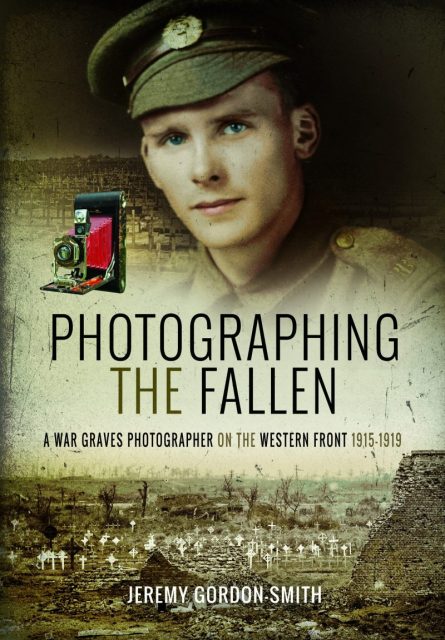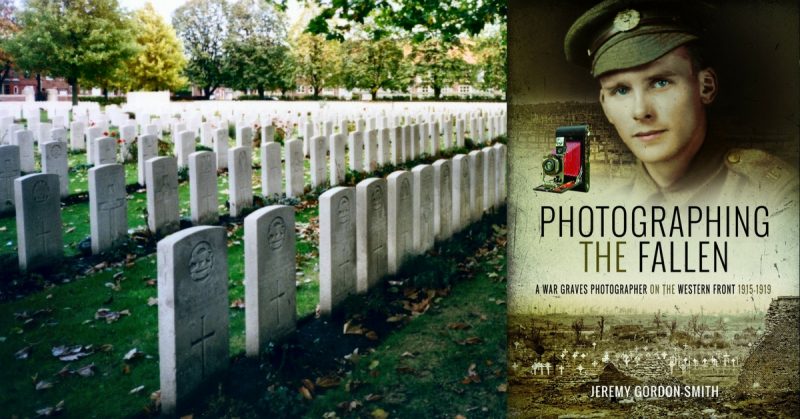Perhaps you’ve had the pleasure of attending a lecture by Andy Robertshaw on either side of the pond where he reminds us that the Great War experience for many soldiers wasn’t about combat, despair or all that nonsense about futility that drives fiction writers and other propagators of myth and legend who have done so well out of the conflict in recent years. The army called up a whole lot of butchers and bakers and candlestick makers for their trade skills. Soldiers needed bread, their horses needed blacksmiths and farriers and in this book by Jeremy Gordon-Smith we learn that the dead needed photographers. Well, actually, that isn’t quite correct. The dead didn’t need anything; it was their grieving relatives and the great bureaucratic machine that was the British Expeditionary Force that needed the snappers.
One of them was Ivan Bawtree, an employee of Kodak in London who went out to Flanders to work for the Graves Registration Commission to record the tens of thousands of graves, the cemeteries and workings of the people making sure all the king’s men were afforded a decent burial. This was a gargantuan task that led to the construction of hundreds of war cemeteries dubbed the greatest architectural project of the age and if you ever see these places as they are today with their lovely lawns and shrubbery, you do have to marvel at how it all got done so promptly in the twenty years following the Armistice.
Ivan Bawtree was a good church going man from Surrey who understood the importance of community and doing things right. He was devoted photographer from a young age and this book will confirm he was also a very good one. He did us the service of leaving a very accessible diary in which he had the ability to describe places, people and events in some style. He had the photographer’s eye for detail and he cared about what he was doing.
The author is his great-great nephew and enjoys that slightly frustrating pleasure of knowing his father and uncle had the chance to spend time with Ivan before he died in 1979 and it is obvious he was a fascinating man who influenced people who knew him. I only had one Great War veteran in my family circle as a child and the only thing he ever said about those years was when I saw the scars on his chest and arms one day when he was rummaging around for a lost packet of cigarettes early one morning. “He pointed to the marks made by shell fragments and said “Don’t you ever get any of these, boy!” and that was it. Nothing else. He died in 1972 when I was 12 years old.
But Ivan left much more of a physical reminder and this book is the sum of much of it. Mr Gordon-Smith writes from the heart as he tells Ivan’s story and those of other relatives who experienced the war to end all wars. We learn about the daily grind of travelling around the battlefields visiting cemeteries and individual graves to photograph the spots where men were buried. Some of this was done under shellfire and always with an element of risk when working in the Ypres Salient. The difficulties of doing the work, building dark rooms and drying facilities, handling glass plate negatives and even the simple act of getting from A to B are all included in Ivan’s story. The author does a lot to get things into context and is careful to remember many of his readers will have only a minimal understanding of the war and its phases.
I found the diary entries and the day-to-day stuff to be quite enthralling and the book really came alive for me after the Armistice when Ivan, who served with the Royal Engineers, began working for the nascent Imperial War Graves Commission. We see all the grizzly stuff of men going out to recover the dead and bringing them in for burial. The author recalls the work of Chinese labourers involved in clearing the battlefield and just what a dangerous place it could be even after the guns had fallen silent.
I’ve reviewed a lot of Great War books and talked often about battlefield touring and the cemeteries. Rudyard Kipling had insured each man could at rest under a headstone confirming he was known unto God and that his memory was not blotted out. The thing that hit me hardest from reading this book was appreciating there are still over 160,000 men out there in France and Belgium who have no grave at all save for the patch of ground they may one day be found in. I’ve heard stories about rich farmland that shields thousands that may never be exhumed.
One man who does have a decent grave is my uncle Leslie. He can be found in Divisional cemetery at Vlamertinghe just a mile and a bit west of Ypres. Ivan almost certainly took the photographs used on one or both of the graves registration cards for my uncle that are treasured items in my family archive.
He had been working in that area and the village is referred to a number of times in his diary and other writing. The fact he was there gives this book extra resonance for me.
We won’t all have that connection, but if you are looking for more from your Great War reading in the form of books that add depth and new dimensions to your understanding of the conflict, then this book really is ideal. Aside from the information, it also happens to be a good read and the photography is outstanding. The author has been busy with Photoshop merging the old and the new to make interesting montages of well-known locations. He is a genuine battlefield pilgrim and this book is not just an exercise to take advantage of the centenaryfest now, happily, in it’s final year. The book acts as a battlefield guide of sorts and will fit well into your bookshelves filled with traditional guides and gazetteers of the war. Above all it is a tribute to the hardy and sensitive men of the Graves Registration units who built the silent cities, the brilliance of Fabian Ware and the IWGC and the on-going work of the Commonwealth War Graves Commission.
And then there is Ivan, a man I would like to have known. That he was a good man shines through the pages of this lovely book. It is fitting to know that he rests in peace.
Reviewed by Mark Barnes for War History Online

PHOTOGRAPHING THE FALLEN
A War Graves Photographer on the Western Front 1915-1919
By Jeremy Gordon-Smith
Pen & Sword Military
ISBN: 978 1 47389 365 8
